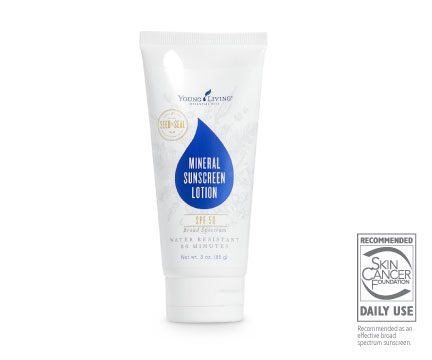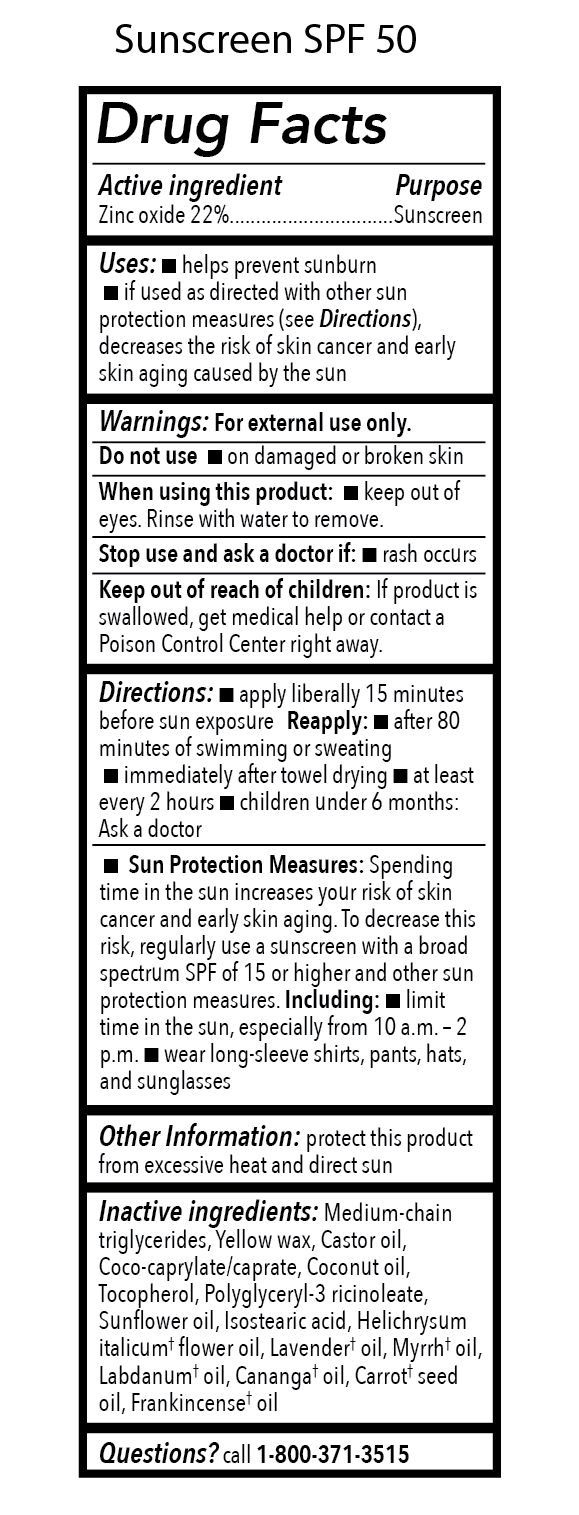 Young Living’s Mineral Sunscreen Lotion SPF 50 expands our over-the-counter line with a new option for sun protection! This natural sunscreen is chemical-free, making it a healthy alternative for adults and kids! Instead of melting in the sun, melt this lightweight, fast-absorbing sunscreen into your skin for added protection from UVA and UVB rays.
Young Living’s Mineral Sunscreen Lotion SPF 50 expands our over-the-counter line with a new option for sun protection! This natural sunscreen is chemical-free, making it a healthy alternative for adults and kids! Instead of melting in the sun, melt this lightweight, fast-absorbing sunscreen into your skin for added protection from UVA and UVB rays.
This dermatologist-reviewed product is formulated to easily smooth on skin without leaving white residue! Enjoy the outdoors worry-free with up to 80 minutes of water- and sweat-resistant lotion. This might just be the best sunscreen you’ve ever used!

|
||
| 3 oz | ||
| Retail | $39.14 |
|
| Wholesale | $29.75 | |
How To Use
- Apply liberally 15 minutes before sun exposure. Reapply after 80 minutes of swimming or sweating, immediately after towel drying, or at least every 2 hours.

Ingredients
- Non-nano zinc oxide
- Yellow wax
- Castor oil
- Coco-caprylate/caprate
- Coconut oil
- Tocopherol
- Polyglyceryl-3 ricinoleate
- Sunflower oil
- Isostearic acid
- Helichrysum†
- Lavender†
- Myrrh†
- Labdanum†
- Cananga†
- Carrot Seed†
- Frankincense†

There’s New Evidence on the Health Benefits of Sun Exposure
Recent studies suggest that sunlight may lower blood pressure in ways that have nothing to do with vitamin D
Sunscreen chemicals have higher concentrations in blood than threshold
A new study tested six of the main active ingredients in sunscreen lotions and sprays and found they had had higher concentrations in the blood than the Food and Drug Administration’s threshold.
“A new approach to studying the effects of two common chemicals [oxybenzone and propylparaben] used in cosmetics and sunscreens found they can cause DNA damage in breast cells at surprisingly low concentrations, while the same dose did not harm cells without estrogen receptors.”
DNA Damage to Breast Cells from chemicals in some cosmetics, sunscreens
A new approach to studying the effects of two common chemicals used in cosmetics and sunscreens found they can cause DNA damage in breast cells at surprisingly low concentrations, while the same dose did not harm cells without estrogen receptors.
What is the importance of SPF – Sun Protection Factor Explained
Whether you’re sitting in the sweltering summer sun at the beach or getting refracted rays off snowy slopes—you still have to watch out for UV rays! No matter how you’re playing in the sunshine, one thing is vital: protecting your skin. Having a natural sunscreen you can count on means more fun outdoors
Mom’s Warning About Aerosol Sunscreens Needs to Be Read by Every Parent
Sunscreen is taken for granted by most as a necessary protectant from the sun. However, it is still part of the unregulated beauty industry and can therefore come with unintended side effects or health risks. Always make sure to check labels for toxicity.
Why Is Sunscreen ‘Better’ in Europe? The trouble with skin protection products in the U.S.
The FDA is currently reviewing the 16 approved ingredients on the market to determine whether they’re really safe for Americans to use. These ingredients focus primarily on protection from UVB rays which don’t penetrate beyond the first layer of skin. In contrast, the European Union regulates sunscreens as cosmetics, and there are at least 27 different approved sunscreen ingredients, many of which offer a better degree of protection against UVA rays. UVA light can cause mutations that lead to skin cancer, immunosuppression, and premature skin aging. The problem is that many of these chemicals used in Europe have been found in breast milk, urine, and amniotic fluid, and some animal studies have suggested that it might have hormone-disrupting effects.
Sunscreen Chemicals Soak All the Way Into Your Bloodstream
But whether that’s a health risk remains unclear, according to a new FDA-backed study.
Page not found – Lindsey Elmore
“Avoidance of sun exposure is a risk factor of a similar magnitude as smoking, in terms of life expectancy.”
“Meanwhile, that big picture just keeps getting more interesting. Vitamin D now looks like the tip of the solar iceberg. Sunlight triggers the release of a number of other important compounds in the body, not only nitric oxide but also serotonin and endorphins. It reduces the risk of prostate, breast, colorectal, and pancreatic cancers. It improves circadian rhythms. It reduces inflammation and dampens autoimmune responses. It improves virtually every mental condition you can think of. And it’s free.”
“Am I willing to entertain the notion that current guidelines are inadvertently advocating a lifestyle that is killing us? I am, because it’s happened before.”
“However, like margarine, early sunscreen formulations were disastrous, shielding users from the UVB rays that cause sunburn but not the UVA rays that cause skin cancer. Even today, SPF ratings refer only to UVB rays, so many users may be absorbing far more UVA radiation than they realize. Meanwhile, many common sunscreen ingredients have been found to be hormone disruptors that can be detected in users’ blood and breast milk. The worst offender, oxybenzone, also mutates the DNA of corals and is believed to be killing coral reefs. Hawaii and the western Pacific nation of Palau have already banned it, to take effect in 2021 and 2020 respectively, and other governments are expected to follow.”
“Here’s why: many experts in the rest of the world have already come around to the benefits of sunlight. Sunny Australia changed its tune back in 2005. Cancer Council Australia’s official-position paper (endorsed by the Australasian College of Dermatologists) states, ‘Ultraviolet radiation from the sun has both beneficial and harmful effects on human health…. A balance is required between excessive sun exposure which increases the risk of skin cancer and enough sun exposure to maintain adequate vitamin D levels…. It should be noted that the benefits of sun exposure may extend beyond the production of vitamin D. Other possible beneficial effects of sun exposure… include reduction in blood pressure, suppression of autoimmune disease, and improvements in mood.'”
The Shady Link Between Sunscreen and Your Health
Current guidelines for sun exposure are unhealthy and unscientific, controversial new research suggests—and quite possibly even racist. How did we get it so wrong?
This App Will Terrify You Into Wearing Sunscreen
Sunscreen isn’t just for preventing sunburns. The sun’s rays are responsible for much of the wrinkling, thickening, and brownish spots that show up ov
Young Living’s SPF 50 Mineral Sunscreen Receives Seal of Recommendation from The Skin Cancer Foundation
Young Living Essential Oils, the world leader in essential oils, announced today that its Mineral Sunscreen Lotion SPF 50 received the Seal of Recommendation from The Skin Cancer Foundation.
From Young Living product support:
The tocopherol in the Mineral Sunscreen Lotion – SPF 10 is extracted from sunflower seeds. The tocopherol in the Mineral Sunscreen Lotion – SPF 50 is derived from soy. It’s an antioxidant that helps keep the formula stable.
$2.2M Settlement Proposed for Babyganics False Ad Class Action
A $2.2M class action settlement with the makers of Babyganics baby care products, will resolve claims that the company’s products are not actually organic.
Just a moment…
Just a moment…
Toxic sunscreen killing coral.
Let’s discuss the difference between Young Living’s Mineral Sunscreen Lotions. Do you really need SPF 50? What does SPF even mean?
Young Living’s Mineral Sunscreen may be a bit more convenient…
via MEME